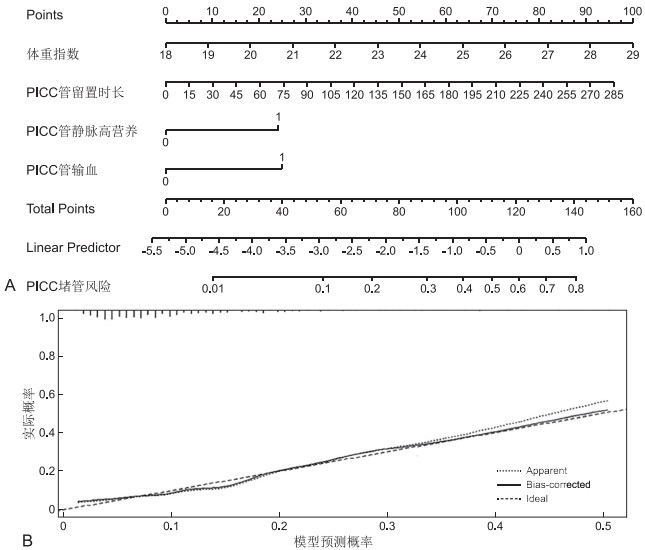Establishment of clinical warning tool based on the influencing factors of PICC catheter occlusion in critically ill patients
-
摘要:
目的 分析重症患者经外周置入中心静脉导管(PICC)并发导管堵塞的危险因素,建立客观的临床预警工具。 方法 回顾性分析2011年4月—2021年4月上海交通大学医学院附属新华医院收治的458例重症患者的临床资料。采用SPSS 23.0统计学软件进行数据分析,其中计量资料组间比较采用成组t检验,计数资料组间比较采用χ2检验。采用二元logistic回归分析筛选PICC导管堵塞的独立危险因素,并采用R软件建立关于导管堵塞的临床预警工具。 结果 研究共纳入458例重症患者,其中导管堵塞组患者57例(12.4%),非导管堵塞组患者401例(87.6%)。多因素二元logistic回归分析结果显示, 体重指数(OR=1.084, 95% CI:1.043~1.126)、PICC管留置时长(OR=1.045,95% CI:1.018~1.073)、PICC管静脉高营养(OR=3.025, 95% CI:1.305~7.014)及PICC管输血(OR=2.773, 95% CI:1.151~6.683)是导管堵塞的独立预测因子。Bootstrap法和校准曲线分析的结果显示,基于上述独立危险因素建立的导管堵塞临床预警工具的预测能力较强且稳定。 结论 重症患者PICC导管堵塞风险不容忽视,基于模型进行堵管风险的预判并为避免人为叠加堵管危险因素提供参考。 -
关键词:
- 重症患者 /
- 外周置入中心静脉导管 /
- 导管堵塞 /
- 危险因素 /
- 临床预警工具
Abstract:Objective To explore the risk factors of peripherally inserted central catheter (PICC) complicated with occlusion in critically ill patients and establish a clinical warning tool. Methods Clinical data of 458 critically ill patients admitted to Xinhua Hospital from April 2011 to April 2021 were retrospectively analyzed. The software SPSS 23.0 was used to perform data analysis. The two-sample t test was applied to perform measurement data comparison and the chi-square test was used to perform count data. Binary logistic regression was applied to screen independent risk factors, and R software was used to establish a nomogram warning tool about occlusion. Results A total of 458 critically ill patients were included, of which 57 patients (12.4%) in the occlusion groups and 401 patients in the non-occlusion groups. The multivariate binary logistic regression analysis showed that the body mass index (OR=1.084, 95% CI: 1.043-1.126), PICC retention time (OR=1.045, 95% CI: 1.018-1.073), PICC intravenous nutrition (OR=3.025, 95% CI: 1.305-7.014) and PICC blood transfusion (OR=2.773, 95% CI: 1.151-6.683) were independent predictor for occlusion. In addition, the Bootstrap method and calibration curve analysis indicated that the predictive ability of the clinical warning tool for catheter occlusion based on the above independent risk factors was strong and stable. Conclusion The risk of PICC occlusion in critically ill patients cannot be ignored. Based on the tool, it could predict the risk of catheter occlusion and provide guidance for avoiding artificial superposition of risk factors. -
表 1 2组PICC置管重症患者临床资料对比
Table 1. Comparison of clinical data of severe patients with PICC catheterization between two groups
项目 导管堵塞组(57例) 非导管堵塞组(401例) 统计量 P值 年龄(x±s,岁) 64.5±16.2 62.4±15.7 0.919a 0.361 性别[例(%)] 男性 30(52.6) 243(60.6) 1.316b 0.451 女性 27(47.4) 158(39.4) BMI(x±s) 27.5±7.5 24.3±7.8 2.912a 0.004 个人史[例(%)] 抽烟 12(21.1) 53(13.0) 2.516b 0.066 饮酒 11(19.3) 68(17.0) 0.192b 0.118 共病[例(%)] 高血压 28(49.1) 182(45.4) 0.281b 0.986 糖尿病 14(24.6) 68(17.0) 1.963b 0.171 心脏病 15(26.3) 95(23.7) 1.193b 0.352 恶性肿瘤 9(15.8) 38(9.5) 5.244b 0.009 肝功能不全 6(10.5) 41(10.2) 6.168b 0.004 肾功能不全 20(35.1) 157(39.2) 0.352b 0.831 凝血功能异常 11(19.3) 46(11.5) 3.143b 0.034 PICC管置入部位[例(%)] 贵要静脉 37(64.9) 261(65.1) 0.187b 0.761 肱静脉 11(19.3) 85(21.2) 0.112b 0.184 头静脉 9(15.8) 55(11.2) 3.677b 0.033 PICC管移位[例(%)] 9(15.8) 36(9.0) 8.212b 0.002 PICC管留置时长(x±s, d) 85.4±22.7 71.6±13.1 4.486a <0.001 PICC管静脉高营养[例(%)] 10(17.5) 32(31.7) 5.344b 0.008 PICC管输血[例(%)] 8(14.0) 27(6.7) 8.557b < 0.001 红细胞(x±s, ×1012/L) 5.3±0.8 5.1±1.2 1.642a 1.013 白细胞(x±s, ×109/L) 6.2±1.6 5.8±2.4 1.644a 1.104 血红蛋白(x±s, g/L) 141.4±45.2 139.6±48.7 0.261a 0.776 注:a为t值,b为χ2值。 表 2 影响导管堵塞发生的独立危险因素分析
Table 2. Analysis of independent risk factors for the occurrence of catheter occlusion
变量 B SE Wald χ2 P值 OR值 95% CI BMI 0.081 0.020 17.095 < 0.001 1.084 1.043~1.126 恶性肿瘤 0.630 0.435 2.098 0.148 1.877 0.801~4.399 肝功能不全 -0.042 0.495 0.007 0.933 0.959 0.364~2.529 凝血功能异常 0.424 0.410 1.071 0.301 1.528 0.685~3.410 头静脉置管 0.065 0.431 0.023 0.880 1.067 0.459~2.482 PICC管移位 0.726 0.437 2.756 0.097 2.067 0.877~4.869 PICC管留置时长 0.044 0.013 11.021 0.001 1.045 1.018~1.073 PICC管静脉高营养 1.107 0.429 6.656 0.010 3.025 1.305~7.014 PICC管输血 1.020 0.449 5.164 0.023 2.773 1.151~6.683 -
[1] SCHULTS J A, KLEIDON T, PETSKY H L, et al. Peripherally inserted central catheter design and material for reducing catheter failure and complications[J]. Cochrane DB Syst Rev, 2019, 7: CD013366. DOI: 10.1002/14651858.cd013366. [2] SHARP R, CARR P, CHILDS J, et al. Catheter to vein ratio and risk of peripherally inserted central catheter (PICC)-associated thrombosis according to diagnostic group: A retrospective cohort study[J]. BMJ Open, 2021, 11(7): e045895. DOI: 10.1136/bmjopen-2020-045895. [3] SMITH S N, MOUREAU N, VAUGHN V M, et al. Patterns and predictors of peripherally inserted central catheter occlusion: The 3P-O study[J]. J Vasc Interv Radiol, 2017, 28(5): 749-756. e2. doi: 10.1016/j.jvir.2017.02.005 [4] YU X H, YUE S J, WANG M J, et al. Risk factors related to peripherally inserted central venous catheter nonselective removal in neonates[J]. Biomed Res Int, 2018: 3769376. DOI: 10.1155/2018/3769376. [5] 伍瑛. 中心静脉导管堵塞危险因素分析及护理干预新进展[J]. 系统医学, 2020, 5(11): 196-198. https://www.cnki.com.cn/Article/CJFDTOTAL-XTYX202011075.htmWU Y. Risk Factors analysis of central venous catheter occlusion and new progress of nursing intervention[J]. Systems Medicine, 2020, 5(11): 196-198. https://www.cnki.com.cn/Article/CJFDTOTAL-XTYX202011075.htm [6] CHO S B, BAEK H J, PARK S E, et al. Clinical feasibility and effectiveness of bedside peripherally inserted central catheter using portable digital radiography for patients in an intensive care unit: A single-center experience[J]. Medicine, 2019, 98(26): e16197. DOI: 10.1097/MD.0000000000016197. [7] PIKWER A, AKESON J, LINDGREN S. Complications associated with peripheral or central routes for central venous cannulation[J]. Anaesthesia, 2012, 67: 65-71. doi: 10.1111/j.1365-2044.2011.06911.x [8] INOUE M. Results of management of 452 upper arm PICC-14, 869 catheter days in a single hospital[J]. J Vasc Access, 2012, 13(1): 21A-22A. DOI: 10.1016/j.java.2016.10.092. [9] CHOPRA V, MONTOYA A, JOSHI D, et al. Peripherally inserted central catheter use in skilled nursing facilities: A pilot study[J]. J Am Geriatr Soc, 2015, 63: 1894-1899. doi: 10.1111/jgs.13600 [10] RATZ D, HOFER T, FLANDERS S A, et al. Limiting the number of lumens in peripherally inserted central catheters to improve outcomes and reduce cost: A simulation study[J]. Infect Control Hosp Epidemiol, 2016, 37: 811-817. doi: 10.1017/ice.2016.55 [11] FLANDERS S A, GREENE M T, GRANT P, et al. Hospital performance for pharmacologic venous thromboembolism prophylaxis and rate of venous thromboembolism: A cohort study[J]. JAMA Intern Med, 2014, 174: 1577-1584. doi: 10.1001/jamainternmed.2014.3384 [12] LOPEZ-BRIZ E, RUIZ GARCIA V, CABELLO J B, et al. Heparin versus 0.9% sodium chloride intermittent flushing for prevention of occlusion in central venous catheters in adults[J]. Cochrane Database Syst Rev, 2014, 8(10): CD008462. DOI: 10.1002/14651858.CD008462. [13] SONG Y, LIU S, LOU T, et al. Risk factors associated with peripherally inserted central catheter-related venous thrombosis in hospitalized patients of advanced age[J]. J Int Med Res, 2020, 48(1): 03000 60518820744. DOI: 10.1177/0300060518820744. [14] RATZ D, HOFER T, FLANDERS S A, et al. Limiting the number of lumens in peripherally inserted central catheters to improve outcomes and reduce cost: A simulation study[J]. Infect Control Hosp Epidemiol, 2016, 37: 811-817. doi: 10.1017/ice.2016.55 [15] NUSSLI S, SCHNYDER F, ZENHAUSERN R, et al. Improving patient safety with a mobile application for patients with peripherally inserted central venous catheters (PICC)[J]. Stud Health Technol Inform, 2016, 225: 952-953. [16] XU B B, ZHANG J H, HOU J M, et al. Nurses ' knowledge of peripherally inserted central catheter maintenance and its influencing factors in Hunan province, China: A cross-sectional survey[J]. BMJ Open, 2020, 10(5): e033804. DOI: 10.1136/bmjopen-2019-033804. [17] CHOPAR V, KUHN L, RATZ D, et al. Vascular nursing experience, practice knowledge, and beliefs: Results from the Michigan PICC1 survey[J]. J Hosp Med, 2016, 11: 269-275. doi: 10.1002/jhm.2523 [18] 黄小琴, 吕东来, 周丽梅. 基于微信平台的延续护理在使用PICC的消化道肿瘤患者中的应用[J]. 中华全科医学, 2021, 19(8): 1419-1422. doi: 10.16766/j.cnki.issn.1674-4152.002075HUANG X Q, LYU D L, ZHOU L M. Observation on the application effect of continuing care based on WeChat platform in patients with gastrointestinal tumors using PICC[J]. Chinese Journal of General Practice, 2021, 19(8): 1419-1422. doi: 10.16766/j.cnki.issn.1674-4152.002075 [19] 潘龙芳, 段均, 张祖莉, 等. 精细化管理在预防PICC导管堵塞中的应用研究[J]. 重庆医科大学学报, 2018, 43(2): 293-296. https://www.cnki.com.cn/Article/CJFDTOTAL-ZQYK201802030.htmPAN L F, DUAN J, ZHANG Z L, et al. Efficacy of delicate management in prevention of periherally inserted central catheter occlusion[J]. Journal of Chongqing Medical University, 2018, 43(2): 293-296. https://www.cnki.com.cn/Article/CJFDTOTAL-ZQYK201802030.htm [20] STAMMERS D, CONNOLLY B, BRANDAO L R, et al. Evaluation of the need for chest X-Rays in the management of asymptomatic, intraluminal vascular access device occlusion in childhood cancer[J]. Pediatr Blood Cancer, 2017, 64(7): 135-142. [21] 浦亚楼, 孟爱凤, 刘春丽, 等. PICC血凝性堵管风险预警评估及相关预防措施的研究进展[J]. 护士进修杂志, 2019, 34(20): 1857-1860. https://www.cnki.com.cn/Article/CJFDTOTAL-FSJX201920007.htmPU Y L, MENG A F, LIU C L, et al. Early warning and preventive measures of blood coagulation-related catheter blockage risk in PICC: A research progress[J]. Journal of Nurses Training, 2019, 34(20): 1857-1860. https://www.cnki.com.cn/Article/CJFDTOTAL-FSJX201920007.htm -





 下载:
下载:


